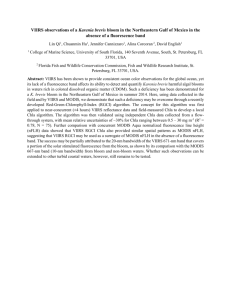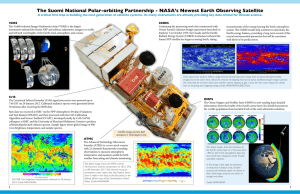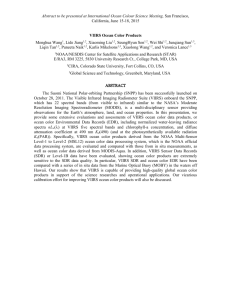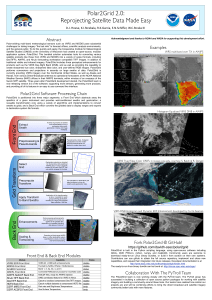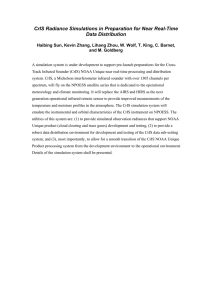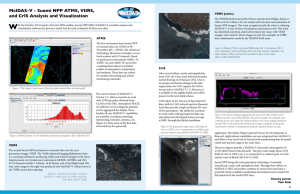Mapping CrIS field of view onto VIIRS Pascal Brunel , Pascale Roquet
advertisement
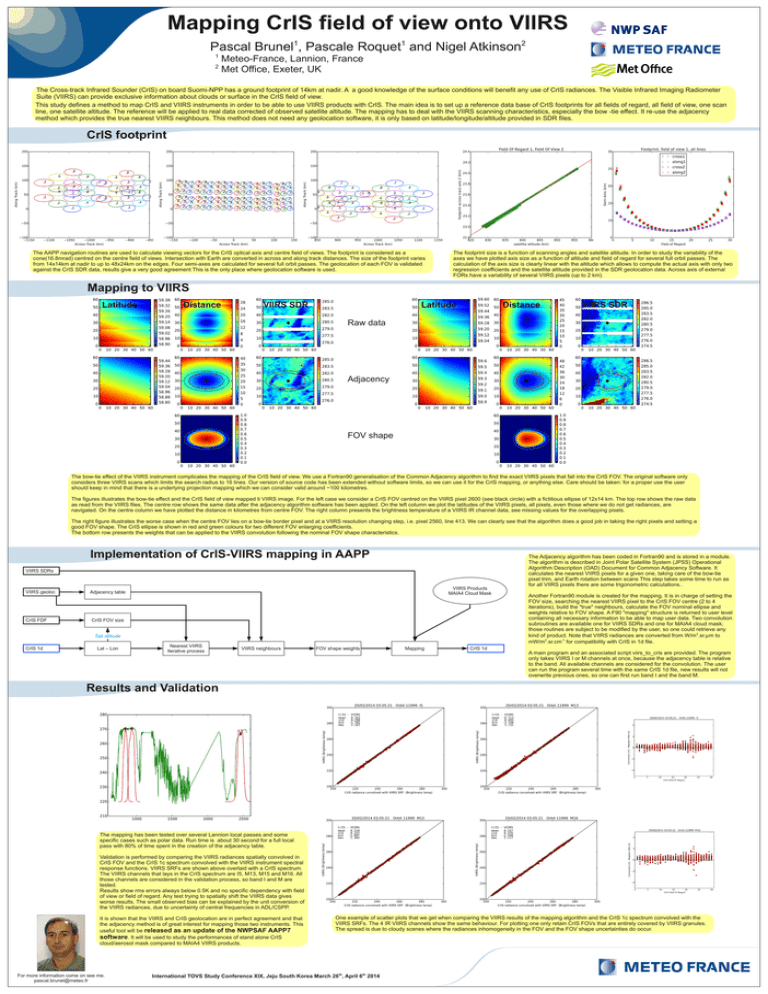
Mapping CrIS field of view onto VIIRS 1 1 Pascal Brunel , Pascale Roquet and Nigel Atkinson 2 1 Meteo-France, Lannion, France 2 Met Office, Exeter, UK The Cross-track Infrared Sounder (CrIS) on board Suomi-NPP has a ground footprint of 14km at nadir. A a good knowledge of the surface conditions will benefit any use of CrIS radiances. The Visible Infrared Imaging Radiometer Suite (VIIRS) can provide exclusive information about clouds or surface in the CrIS field of view. This study defines a method to map CrIS and VIIRS instruments in order to be able to use VIIRS products with CrIS. The main idea is to set up a reference data base of CrIS footprints for all fields of regard, all field of view, one scan line, one satellite altitude. The reference will be applied to real data corrected of observed satellite altitude. The mapping has to deal with the VIIRS scanning characteristics, especially the bow -tie effect. It re-use the adjacency method which provides the true nearest VIIRS neighbours. This method does not need any geolocation software, it is only based on latitude/longitude/altitude provided in SDR files. CrIS footprint The AAPP navigation routines are used to calculate viewing vectors for the CrIS optical axis and centre field of views. The footprint is considered as a cone(16.8mrad) centred on the centre field of views. Intersection with Earth are converted in across and along track distances. The size of the footprint varies from 14x14km at nadir to up to 48x24km on the edges. Four semi-axes are calculated for several full orbit passes. The geolocation of each FOV is validated against the CrIS SDR data, results give a very good agreement This is the only place where geolocation software is used. The footprint size is a function of scanning angles and satellite altitude. In order to study the variability of the axes we have plotted axis size as a function of altitude and field of regard for several full orbit passes. The calculation of the axis size is clearly linear with the altitude which allows to compute the actual axis with only two regression coefficients and the satellite altitude provided in the SDR geolocation data. Across axis of external FORs have a variability of several VIIRS pixels (up to 2 km). Mapping to VIIRS Latitude Distance VIIRS SDR Latitude Distance VIIRS SDR Raw data Adjacency FOV shape The bow-tie effect of the VIIRS instrument complicates the mapping of the CrIS field of view. We use a Fortran90 generalisation of the Common Adjacency algorithm to find the exact VIIRS pixels that fall into the CrIS FOV. The original software only considers three VIIRS scans which limits the search radius to 16 lines. Our version of source code has been extended without software limits, so we can use it for the CrIS mapping, or anything else. Care should be taken: for a proper use the user should keep in mind that there is a underlying projection mapping which we can consider valid around ~100 kilometres. The figures illustrates the bow-tie effect and the CrIS field of view mapped ti VIIRS image. For the left case we consider a CrIS FOV centred on the VIIRS pixel 2600 (see black circle) with a fictitious ellipse of 12x14 km. The top row shows the raw data as read from the VIIRS files. The centre row shows the same data after the adjacency algorithm software has been applied. On the left column we plot the latitudes of the VIIRS pixels, all pixels, even those where we do not get radiances, are navigated. On the centre column we have plotted the distance in kilometres from centre FOV. The right column presents the brightness temperature of a VIIRS IR channel data, see missing values for the overlapping pixels. The right figure illustrates the worse case when the centre FOV lies on a bow-tie border pixel and at a VIIRS resolution changing step, i.e. pixel 2560, line 413. We can clearly see that the algorithm does a good job in taking the right pixels and setting a good FOV shape. The CrIS ellipse is shown in red and green colours for two different FOV enlarging coefficients. The bottom row presents the weights that can be applied to the VIIRS convolution following the nominal FOV shape characteristics. Implementation of CrIS-VIIRS mapping in AAPP VIIRS SDRs VIIRS geoloc CrIS FDF VIIRS Products MAIA4 Cloud Mask Adjacency table CrIS FOV size Sat altitude CrIS 1d Lat – Lon Nearest VIIRS Iterative process VIIRS neighbours FOV shape weights Mapping CrIS 1d The Adjacency algorithm has been coded in Fortran90 and is stored in a module. The algorithm is described in Joint Polar Satellite System (JPSS) Operational Algorithm Description (OAD) Document for Common Adjacency Software. It calculates the nearest VIIRS pixels for a given one, taking care of the bow-tie pixel trim, and Earth rotation between scans This step takes some time to run as for all VIIRS pixels there are some trigonometric calculations.. Another Fortran90 module is created for the mapping. It is in charge of setting the FOV size, searching the nearest VIIRS pixel to the CrIS FOV centre (2 to 4 iterations), build the "true" neighbours, calculate the FOV nominal ellipse and weights relative to FOV shape. A F90 "mapping" structure is returned to user level containing all necessary information to be able to map user data. Two convolution subroutines are available one for VIIRS SDRs and one for MAIA4 cloud mask; those routines are subject to be modified by the user, so one could retrieve any kind of product. Note that VIIRS radiances are converted from W/m 2.sr.m to mW/m2.sr.cm-1 for compatibility with CrIS in 1d file. A main program and an associated script viirs_to_cris are provided. The program only takes VIIRS I or M channels at once, because the adjacency table is relative to the band. All available channels are considered for the convolution. The user can run the program several time with the same CrIS 1d file, new results will not overwrite previous ones, so one can first run band I and the band M. Results and Validation The mapping has been tested over several Lannion local passes and some specific cases such as polar data. Run time is about 30 second for a full local pass with 80% of time spent in the creation of the adjacency table. Validation is performed by comparing the VIIRS radiances spatially convolved in CrIS FOV and the CrIS 1c spectrum convolved with the VIIRS instrument spectral response functions. VIIRS SRFs are shown above overlaid with a CrIS spectrum. The VIIRS channels that lays in the CrIS spectrum are I5, M13, M15 and M16. All those channels are considered in the validation process, so band I and M are tested. Results show rms errors always below 0.5K and no specific dependency with field of view or field of regard. Any test trying to spatially shift the VIIRS data gives worse results. The small observed bias can be explained by the unit conversion of the VIIRS radiances, due to uncertainty of central frequencies in ADL/CSPP. It is shown that the VIIRS and CrIS geolocation are in perfect agreement and that the adjacency method is of great interest for mapping those two instruments. This useful tool will be released as an update of the NWPSAF AAPP7 software. It will be used to study the performances of stand alone CrIS cloud/aerosol mask compared to MAIA4 VIIRS products. For more information come on see me. pascal.brunel@meteo.fr One example of scatter plots that we get when comparing the VIIRS results of the mapping algorithm and the CrIS 1c spectrum convolved with the VIIRS SRFs. The 4 IR VIIRS channels show the same behaviour. For plotting one only retain CrIS FOVs that are entirely covered by VIIRS granules. The spread is due to cloudy scenes where the radiances inhomogeneity in the FOV and the FOV shape uncertainties do occur. International TOVS Study Conference XIX, Jeju South Korea March 26 th, April 6th 2014

